We left Durban on Saturday morning, the 10th of December, and headed straight for St. Lucia, a World Heritage Site located on the shores of the Indian Ocean halfway between Durban and Swaziland (http://whc.unesco.org/pg.cfm?cid=31&id_site=914) . To say it was hot and humid would be an understatement of immense magnitude…Durban was hot and humid: St.Lucia was sultry and sweltering…and lush, and green and tropical.
The three hour drive to St. Lucia took us through miles and miles of sugar estates (sugar cane farms). Waves of rolling hills covered with the tall cane grass rippled with the shifting winds, clusters of trees and farmhouses standing out like so many oases in a desert of green. We passed the hulking red heaps of the sand mines at Richard’s Bay, and soon found ourselves on a narrow paved road with wide green verges cut through the middle of a eucalyptus paper forest…a forest planted by one of the local paper companies. We emerged at a bridge from which we could see a dock and a tour boat and at the other side of the bridge we found the little town of St. Lucia.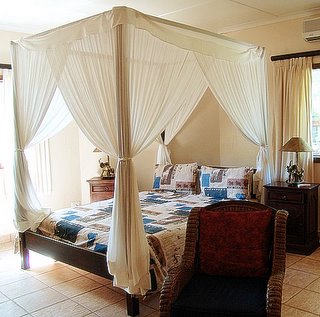 The air conditioning in the car and our hotel room provided welcome respite from the heat, but, surprisingly, it wasn’t as bad as I expected (I don’t handle humidity all that well). As long as there was a breeze, it was tolerable and so we set about to explore our environment. The room was lovely, with a fully functional mosquito net, designed as a decorative curtained canopy, draped over the bed. Fortunately, with the aircon, we didn't need it...we just closed up the windows and turned on the cool air. After settling into our hotel, the "Hippo Hideaway," we headed back to that bridge, camera in hand, and took an afternoon boat ride on the St. Lucia Estuary.
The air conditioning in the car and our hotel room provided welcome respite from the heat, but, surprisingly, it wasn’t as bad as I expected (I don’t handle humidity all that well). As long as there was a breeze, it was tolerable and so we set about to explore our environment. The room was lovely, with a fully functional mosquito net, designed as a decorative curtained canopy, draped over the bed. Fortunately, with the aircon, we didn't need it...we just closed up the windows and turned on the cool air. After settling into our hotel, the "Hippo Hideaway," we headed back to that bridge, camera in hand, and took an afternoon boat ride on the St. Lucia Estuary.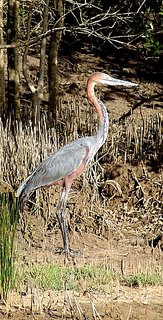 I like birds. Since I am allergic to the lovely creatures, however, I can’t keep a pet bird, so I must content myself with viewing the wild ones, many of which visit our large back garden at home. Hubby, bless his heart, is mostly bored with my bird-prattle, but knowing how much I enjoy looking at the creatures, booked St. Lucia because he had heard there was abundant birdlife there…and he heard right. The cruise up the Estuary showed us Egyptian geese and Goliath heron (a fairly rare bird, shown at right), white egrets and cranes, any number of stilt-legged shore birds probing the muddy beaches with their needle-like beaks. We watched a pied kingfisher hover and dart for its food and observed the majestic African Fish Eagle, a dead ringer for the American Bald Eagle, roosting high in the branches of a waterside tree. But the cluster of rocks we saw in the distance, something dismissed originally as uninteresting lumps of stone, turned out to be one of the highlights of the trip: a pod of hippo!
I like birds. Since I am allergic to the lovely creatures, however, I can’t keep a pet bird, so I must content myself with viewing the wild ones, many of which visit our large back garden at home. Hubby, bless his heart, is mostly bored with my bird-prattle, but knowing how much I enjoy looking at the creatures, booked St. Lucia because he had heard there was abundant birdlife there…and he heard right. The cruise up the Estuary showed us Egyptian geese and Goliath heron (a fairly rare bird, shown at right), white egrets and cranes, any number of stilt-legged shore birds probing the muddy beaches with their needle-like beaks. We watched a pied kingfisher hover and dart for its food and observed the majestic African Fish Eagle, a dead ringer for the American Bald Eagle, roosting high in the branches of a waterside tree. But the cluster of rocks we saw in the distance, something dismissed originally as uninteresting lumps of stone, turned out to be one of the highlights of the trip: a pod of hippo!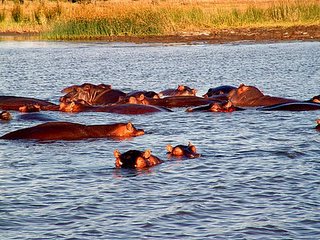 Sheep cluster in flocks, cattle and horses in herds, geese in gaggles…and hippos cluster in pods, like whales. We learned that because hippo young are born under water and suckle under water, like the young of such marine mammals as whales and dolphins, their groups are called pods as well. You cannot imagine how big these things are until you actually see one up close and personal. I’ve seen many of these things in the zoo and believe me, it’s just not the same. They can appear and disappear from the water in a silent instant, leaving not even a ripple in the choppy estuary waters to mark their presence. For such immense animals, they are eerily silent in their movements, although their vocalizations sound surprisingly like a man’s snores! Hippos are vegetarians and they emerge at night, when there is no sun to burn their skin, to browse on shore. “Beware of Hippo” signs abound!
Sheep cluster in flocks, cattle and horses in herds, geese in gaggles…and hippos cluster in pods, like whales. We learned that because hippo young are born under water and suckle under water, like the young of such marine mammals as whales and dolphins, their groups are called pods as well. You cannot imagine how big these things are until you actually see one up close and personal. I’ve seen many of these things in the zoo and believe me, it’s just not the same. They can appear and disappear from the water in a silent instant, leaving not even a ripple in the choppy estuary waters to mark their presence. For such immense animals, they are eerily silent in their movements, although their vocalizations sound surprisingly like a man’s snores! Hippos are vegetarians and they emerge at night, when there is no sun to burn their skin, to browse on shore. “Beware of Hippo” signs abound!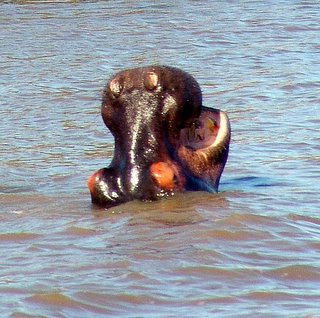 "Hippopotamus" means "river horse" (in Greek, I think) and in Afrikaans they are called "seekoei," or "sea cow." It is difficult to imagine why on first glance, since they appear to be bulky, lumbering and slow, but we were told that despite their bulk, they can run at respectably frightening speeds on land and that they do not swim in the rivers and estuaries, but "run" in the water. If you have ever tried running with most of your body submerged and experienced the substantial resistance water provides, you will have some insight into the swiftness of this animal on land...if it can successfully run in the resistant water, imagine what it can do in virtually unresisting air!
"Hippopotamus" means "river horse" (in Greek, I think) and in Afrikaans they are called "seekoei," or "sea cow." It is difficult to imagine why on first glance, since they appear to be bulky, lumbering and slow, but we were told that despite their bulk, they can run at respectably frightening speeds on land and that they do not swim in the rivers and estuaries, but "run" in the water. If you have ever tried running with most of your body submerged and experienced the substantial resistance water provides, you will have some insight into the swiftness of this animal on land...if it can successfully run in the resistant water, imagine what it can do in virtually unresisting air!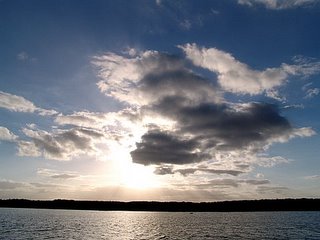 The weather in St. Lucia is nothing if not unpredictable. Heat and humidity are a given, but like Hawaii, if there is even a hint of a breeze, it's just not that bad. But we arrived in St. Lucia in the early afternoon to clear blue skies and daunting sunlight, only to find ourselves racing a storm back to the boat launch site. In a matter of just a few hours the day had gone from the South African sun beating down on us to threatening rain...a threat that was realized just as we sat down to dinner...outside, of course. After fiddling with the camera a bit, I was able to get a picture of one of the storm clouds as it turned our sunny boat ride cool and dark.
The weather in St. Lucia is nothing if not unpredictable. Heat and humidity are a given, but like Hawaii, if there is even a hint of a breeze, it's just not that bad. But we arrived in St. Lucia in the early afternoon to clear blue skies and daunting sunlight, only to find ourselves racing a storm back to the boat launch site. In a matter of just a few hours the day had gone from the South African sun beating down on us to threatening rain...a threat that was realized just as we sat down to dinner...outside, of course. After fiddling with the camera a bit, I was able to get a picture of one of the storm clouds as it turned our sunny boat ride cool and dark.
We returned to our hotel room after stopping at an outdoor market to buy pineapples. My mother-in-law had asked that we bring back a few for her and, since Hubby and I both love pineapple, we picked up a few for ourselves. After a night in the fridge, they provided a cool, refreshing breakfast for us the next morning as we headed out on our next adventure: a guided tour of the Cape Vidal wilderness area aboard one of those safari trucks.
Next entry: safari truck, kudu, and those man-eating crocodiles.
Wednesday, January 04, 2006
It was a sultry, sweltering night...
Subscribe to:
Post Comments (Atom)








No comments:
Post a Comment
Your comments welcome! Anonymous comments are enabled as a courtesy for people who are not members of Blogger. They are not enabled to allow people to leave gratuitously rude comments, and such comments will not be published. Disagreement will not sink your comment, but disagreeable disagreement will.